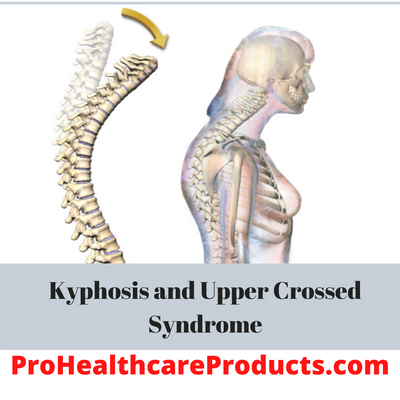 8th Dec 2021
8th Dec 2021
Kyphosis and Upper Crossed Syndrome
Our spinal column has four segments, the cervical (neck), thoracic (ribcage area), lumbar (low back), and sacral/coccygeal (pelvic area and tailbone) segments. From the back the spinal column should look straight and vertical. From a side view, there are four curves. The direction of a spinal curve is named according to the convexity of the curve, not the concavity of the curve. The cervical and lumbar spinal segments curve anterior while the thoracic and sacral spinal segments curve posterior.
Simply defined, kyphosis is an increase in the posterior curvature of the thoracic spine that measures 50 degrees or greater on an x-ray of the spine and is considered a spinal deformity. Some general terms often associated with kyphosis are hunch back, rounded back, etc. Kyphosis can be present at birth (congenital – malformations of the vertebral body during intrauterine development) where the individual is born with abnormally (wedge) shaped vertebrae or caused by several different mechanisms occurring after birth (acquired). These include:
- Developmental abnormalities such as Scheuermann’s disease that produces a “wedge shaped” disc or discs. This typically occurs during the ages of 13 to 16 when the thoracic vertebrae are experiencing some of their greatest growth.
- Neuromuscular conditions caused by neuropathic and myopathic diseases such as cerebral palsy, muscular dystrophy, myelomeningocele, neurofibromatosis, and Paget disease.
- Metabolic disorders such as osteogenesis imperfecta, a condition that causes bones to become fragile and fracture easily.
- Inflammatory diseases such as ankylosing spondylitis, an inflammatory rheumatic disease that affects parts of but usually most of the entire spine.
- Traumatic injury where impact forces cause fractures and/or dislocations of the vertebrae and can develop into a kyphotic deformity, “especially if the injury is not treated promptly” or properly. It is then referred to as “Post-Traumatic Kyphosis” and “in patients with post-traumatic kyphosis, the curve may exceed the normal range, usually in a small segment of the spine. This occurs when fractures or the vertebrae cause wedging, and the normally block-shaped vertebrae become angulated, resulting in a spinal deformity, pain, and a limited range of motion.” (https://www.hss.edu/conditions_post-traumatic-kyphosis-overview.asp) Often times “patients with post-traumatic kyphosis . . . . have severe neurologic deficits such quadriplegia or paraplegia . . . . and can result in chronic, disabling pain”. https://www.srs.org/patients-and-families/conditions-and-treatments/parents/kyphosis/post-traumatic-kyphosis.
- Postural deviations that place abnormal forces on the thoracic spine leading to muscle, ligamentous, and in time bony changes that alter the shape of the spinal segments and thus the spinal curve. This type of kyphosis is contributed to habitual “poor posture” such as slouching, excessive use of modern technology such as computer work or iphone usage, or any other environmental conditions (work setting or entertainment) that cause a person to hunch over producing a posture of rounded shoulders, forward head, and hyper-lordotic curve in the cervical region of the spine.
In addition to postural deviations leading to the condition of kyphosis, the abnormal forces produced by this type of postural deviation can also lead to a condition called Upper Crossed Syndrome. Upper Crossed Syndrome is an abnormal posture involving an imbalance between agonist-antagonist muscles groups where the pectoral muscles, scapular elevator muscles, and sub-occipital muscle group are tight and lacking in proper flexibility, and the neck flexors, scapular retractor muscles, and thoracic extensor muscles are weak and unable to provide sufficient counterbalance to support proper posture.
Both postural kyphosis and upper crossed syndrome are postural deviations that can be corrected or improved with consistent and appropriate therapeutic interventions that are targeted to 1) strengthen the weak muscles, 2) stretch the tight muscles, and 3) promote strategies to maintain a healthy, normal posture at all times.
References
https://www.hss.edu/conditions_post-traumatic-kyphosis-overview.asp
Lynn Perkes is a full-time faculty member at Brigham Young University-Idaho teaching courses in Kinesiology and Biomechanics, Applied Kinesiology and Assessment, Therapeutic Exercise, and other Physical Therapist Assistant classes.





